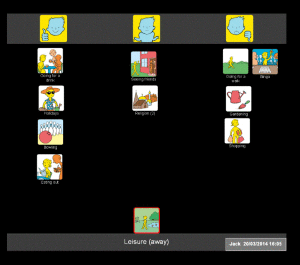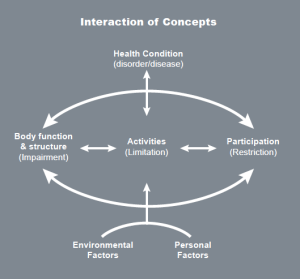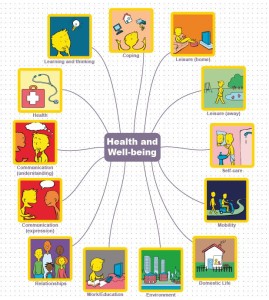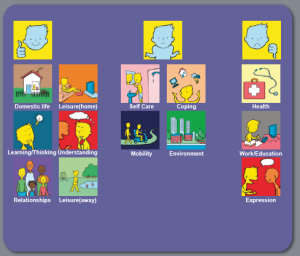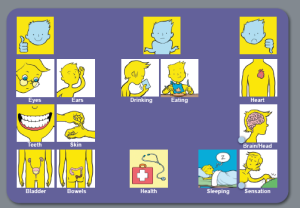In a previous Blog, Joan talked about the four purposes of communication (Light 1988):
1. Expression of needs and wants
2. Information transfer
3. Social closeness
4. Social etiquette
Social closeness can often be overlooked when we support people with communication difficulties, as there can be a temptation to focus on what some see as the ‘important things’ – helping people to express their needs and wants or to transfer information. Social closeness is the glue which binds us together and helps us to form and maintain relationships. It’s really important that we establish this before we start exploring some of the difficult issues that many of the people we are working with face. In my work with people with severe aphasia, I spend time getting to know what matters to them and finding out what their interests are. This is a crucial part of building a relationship with the person and their family. It also provides a much more concrete starting point for beginning to explore rehabilitation goals, as this example shows:
When working with Jack (a man with severe receptive and expressive aphasia), I started by using Talking Mats to ask him how he felt about leisure activities. This was a great way to get to know Jack as a person and to find out his interests. During our conversation, Jack told me that he enjoyed going out for a drink but hated shopping and bingo – and we all had a laugh as he told me this. Jack also told me that he used to like ten pin bowling. He pointed to his leg to indicate that this was something he could no longer participate in as he was now in a wheelchair. I could see that this was important to Jack, so we talked about possible ways round his physical difficulties. Jack agreed that this was something he could work on with the help of his family and the rehabilitation team.
Given that Jack had severe receptive aphasia, if I had started by using Talking Mats to identify specific problems (using a top scale of ‘managing’ and ‘not managing’) as part of the goal setting process, it is highly likely that Jack would have found this too abstract and difficult to engage in. By using the more concrete topic of leisure (with a top scale of ‘like’/’dislike’), Jack was able to reflect on his life since his stroke and tell me how he felt about his restricted physical abilities. I was also able to build up a picture of him as a person and we had fun at the same time.
When using the Health and well-being resource, think about the person you are working with in relation to the ideas and concepts that they can cope with. Exploring leisure activities is a great way to start as it means you can establish rapport by finding out what matters to them.
Have a look at this Blog to see how other people have used a topic such as leisure to build social closeness.
The Health and Well-being resource is based on the WHO International Classification of Functioning, Disability and Health (ICF) which is a framework which covers almost every aspect of daily life and can be applied over different cultures (WHO 2001).
Use of the WHO ICF helps professionals to think holistically about the people they are working with. We have produced four sets of symbols, based on WHO ICF, to help people express their views about different aspects of their lives. These cover 13 topics:
You can use the symbols in different ways, depending on the cognitive abilities of the person you are working with. For example, if you are working with someone who can understand abstract concepts, you could start with the 13 main health and well-being symbols. Your top scale might be ‘managing’ and ‘not managing’. Here is an example of a mat completed by Duncan who had a stroke which affected his ability to communicate through speech:
Using these symbols as a starting point, Duncan could tell us that his main concerns related to worries about his health, expressive communication and work. From here, we did ‘sub mats’ to help Duncan identify the specific areas he wanted to work on/explore.
Here is the mat Duncan completed in relation to his health:
Having done this mat with Duncan, it became clear that he was worried about various aspects of his health, particularly the risk of having another stroke. The wider team were able to give him and his wife information about stroke prevention. Other mats were also completed, exploring expressive communication, work and education and higher level communication (which is included in the ‘learning and thinking’ topic, and covers written communication as well as memory and concentration). Using the Health and Well-being symbols, we were able to work with Duncan to help him identify the main issues that he wanted to work on and then work towards more specific rehabilitation goals. Duncan had copies of all the mats he had completed and found it useful to refer to them over the months. This helped everybody stay on track in relation to his goals and he was also able to track his progress over time.
Have a look at our Health and Well-being resource on our website. It is available both as an original Talking Mat with a physical mat and symbol cards or as a digital version as part of The Talking Mats pro subscription
Has Talking Mats been used in court ?
This is a question that we have often been asked and up until now we have been until able to give examples. On a recent training in Belfast there were two registered intermediaries, their role is to assist vulnerable witnesses and defendants with communication difficulties in the criminal justice system. The registered intermediaries scheme was set up in England and Wales and more recently was established in Northern Ireland. On the course they talked about two cases where Talking Mats was used as part of the achieving best evidence (ABE) interviews.
1. The first case was the case of R versus James Michael Watts http://www.bailii.org/ew/cases/EWCA/Crim/2010/1824.html . Here the clinical forensic psychologist used them to support an individual with severe disabilities to express her view of what had happened.
2. The second case that was discussed was the work of a registered intermediary, Catherine ‘O’Neil where she used them with a young man called Tim in his early twenties who had been severely stabbed and suffered a severe head injury which resulted in locked in syndrome. He had some very limited movement of his hand. Initially, Catherine worked with him to establish a yes/ no and then went on to assess Tim’s ability to use Talking Mats. The focus of the first Talking Mat was to find out about his interests and to enable Catherine and Tim to engage and interact with each other. Catherine said ‘he seemed totally relieved to be able to communicate his narrative. This allowed us to get to know him and his likes, dislikes and interests. Tim had never been a great friend of the police and in the like/dislikes/ don’t know mat, I included many pictures including Basketball, which went slowly but immediately to YES; Snakes under No and Police he joked and eye pointed to the door.!’ Catherine went on to use Talking Mats and these were used jointly with the police in 5 ABE interviews. This did enable evidence to be gathered in terms of the assault weapon, people etc. Through the support of a skilled registered intermediary Talking Mats contributed to enabling the victim to have a voice at the trial where otherwise none would be had. In this case a conviction was made.
We like to keep up to date about how Talking Mats is being used. You may well know of other cases where Talking Mats is being used to support people with communication disability to access justice. If so we would love to hear about them so please let us know.
I like my iPad and I LOVE the new Talking Mats app.
My 89 year old mum lives on her own about 2 hours from where I live and enjoys looking at photos on my iPad Mum has ‘all her marbles’, as the saying goes, and freely expresses her extreme views on current affairs, politics and photographs in Hello magazine! More difficult however, is discussing her failing energy levels and physical strength. She has till now resisted all suggestions of moving house to somewhere with more support.
I knew she would be interested in the Talking Mats app and a demonstration one afternoon flowed naturally into the Domestic topic of the Health and Well Being section. Suddenly we were in the middle of that difficult conversation we’d both been avoiding. Mum fully engaged with the app and changed the position of some items after consideration
The reality is she isn’t managing, she’s struggling. For the first time using the Talking Mats app she confessed to all domestic tasks being difficult even with the bits and pieces of help going in regularly.
The app made that bit easy. Making a decision about the next step will be more difficult.
Rhona Matthews
The final part of my keynote talk at the AAC Conference in Helsinki last month focused on what we mean by communication effectiveness.
It is important to be able to determine the effectiveness / success of an interaction between two people, whether they are politicians, parent and child, husband and wife….. people using AAC systems or people using their own speech.
When I carried out a literature search of peer reviewed journals for my PhD in 2009 I could find no clear definition of communication effectiveness. Some people thought that effectiveness was synonymous with ‘word intelligibility’ or ‘correct syntax’. Others defined effectiveness in terms of the number of words produced on an AAC device. One publication even suggested that effectiveness was demonstrated by someone taking responsibility for charging their AAC device!
The main focus of all the papers I found, which mentioned communication effectiveness, was on needs and wants and only 3 papers cited social closeness as important (click here to read previous blog).
However, some publications did give useful pointers. Light (1988) emphasised that effective communication depends on 2 way interaction and that the partner is a major factor in the success or failure of communicative interactions. Lund (2006) described adequacy, relevance, promptness and communication sharing as key indicators. Ho et al (2005) highlighted satisfaction – partners’ feeling of how well they communicated during the conversation. Locke (1998) stressed that determining the success of any communication is a subjective undertaking as ‘Communication is not a mathematical formula of phonemes, morphemes and syntax, but rather includes casual conversation such as gossip’.
The Talking Mats team has tried to capture what we believe are the essential factors in determining communication effectiveness. We have produced a simple tool – the Effectiveness Framework of Functional Communication (EFFC) which can be used to chart key factors in an interaction on a 5 point scale and give an overall indication of whether the conversation is effective or not.
We have used the EFFC in several of our research projects and show participants how to use it during our training workshops. In Finland I tried it out with the audience of 200 AAC professionals using 3 video examples of different AAC conversations. The resulting scores were amazingly in agreement suggesting that this is a reliable tool.
For a free download please click here EFFC 2014
We would welcome any comments or questions.
 Online training login
Online training login 

